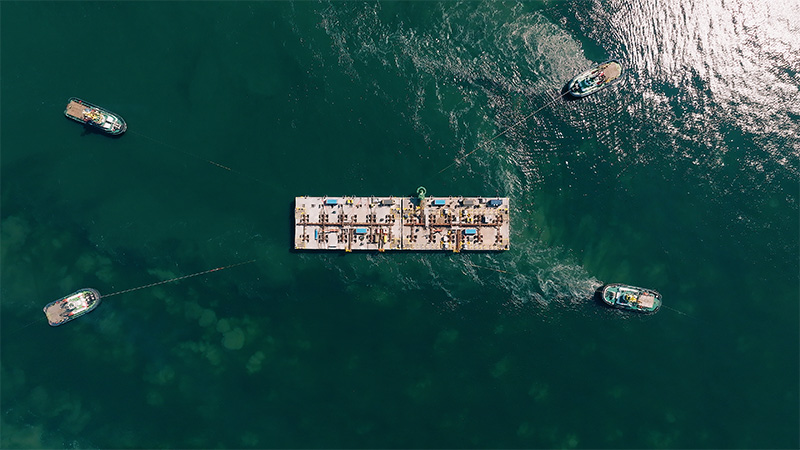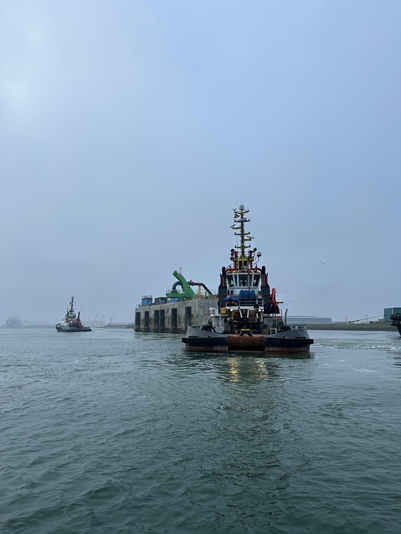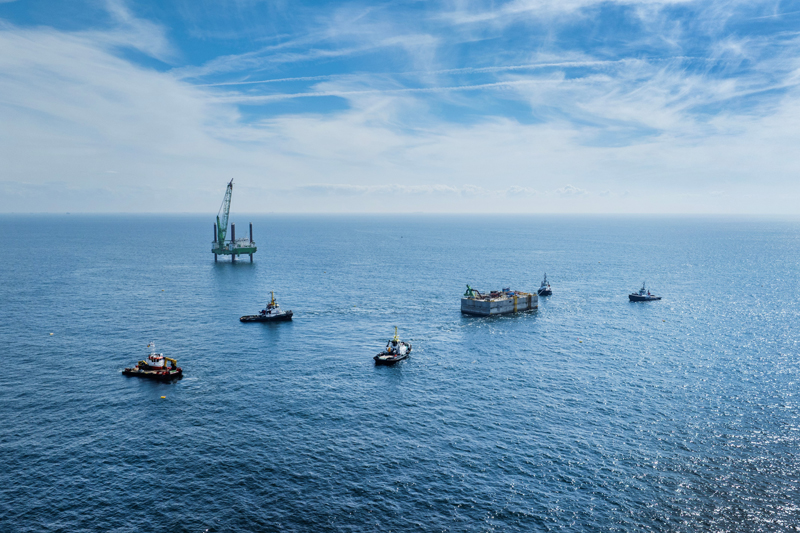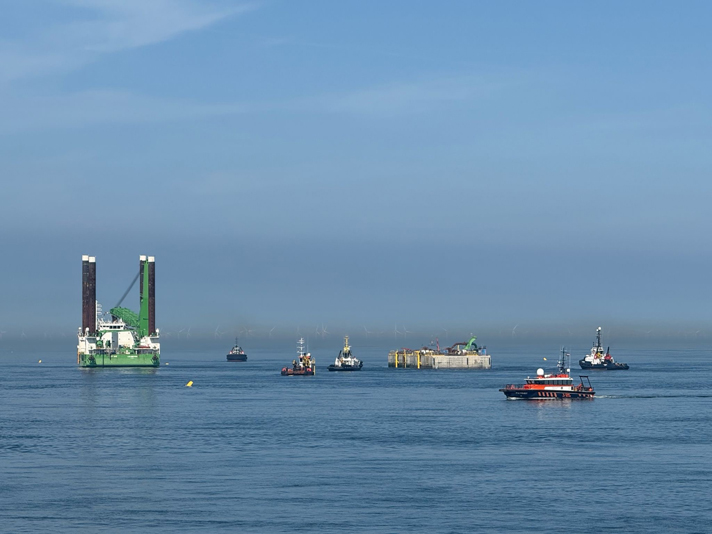30 April 2025
First building blocks of Belgian energy island successfully placed in the North Sea
VLISSINGEN (NL) – NORTH SEA (BE) | Construction has begun in the Belgian North Sea on the Princess Elisabeth Island, an artificial energy island located 45 km off the coast. After a successful sea transport operation, the first two of a total of 23 caissons have been submerged at their final location. Caissons are concrete building blocks that form the outline of the future island. In a later phase, the interior will be filled with sand to build high-voltage infrastructure that will connect new offshore wind farms. The work is being carried out on behalf of grid operator Elia Transmission Belgium (Elia) by TM Edison, a consortium of Belgian marine construction companies DEME and Jan De Nul. In the coming decades, the energy island will become an essential part of Belgium’s electricity supply.
Complex maritime operation
The transport and installation of the caissons at sea is a technically complex operation that began on Easter Monday, 21 April 2025. Each caisson weighs approximately 22,000 tons and measures 58 meters in length, 28 meters in width, and between 23 and 32 meters in height, depending on the presence of a storm wall. For the transport from the port of Vlissingen—where they are built—four powerful tugboats are used to tow each caisson via the Western Scheldt and the North Sea to the island site; covering a distance of approximately 53 nautical miles or 98 kilometres. The complete installation cycle—from departure from the port to placement and fixation at the final destination—takes about 24 hours.
Figure 1: Sea transport route

Once at its destination, the caisson is connected to pre-installed anchors and positioned above the foundation zone (see Figure 2). Advanced surveying techniques, continuous monitoring, and precise tidal measurements ensure that the concrete structure is lowered with great precision. The caisson is then filled with water, allowing it to descend to the seabed in a controlled and stable manner.
This is followed by the next construction phase: placing rock armour around the submerged caisson to protect it against potential summer storms, filling the caisson with sand, and preparing for the installation of the next caisson. Finally, the opening between the caissons is sealed to prevent sand from escaping later when the interior surface is filled.
Figure 2: Positioning of the first caisson via eight anchor points for stable lowering
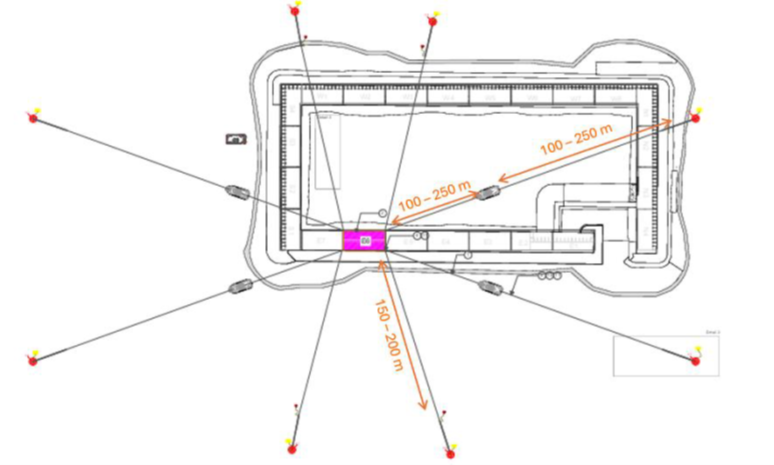
Close monitoring of risks and weather conditions
The operation involves about ten vessels, including four tugboats, a multicat vessel, and dredging, transport, and installation ships. In total, around 150 people are participating. The operation requires extremely precise planning and is carried out in close collaboration with the Rescue and Coordination Centre (MRCC) in Ostend, the Joint Nautical Authority and North Sea Port. Emergency procedures, maritime evacuation plans, and strict communication protocols have been developed according to the highest safety standards. All involved have been trained accordingly.
The transport and placement of the caissons at sea are also highly dependent on tidal movements and weather conditions. The operation only proceeds if waves do not exceed 1.5 metres and wind speeds remain below 5 Beaufort. Two independent weather forecasting services and multiple buoy measurements provide real-time monitoring.
Technological achievement
The successful placement of the first caissons marks an important milestone in the construction of the Belgian energy island. It also demonstrates the expertise of Belgian companies in complex marine engineering works. In the coming months, the east side of the island will first be completed, after which work will begin on the south side. The speed of progress depends entirely on weather conditions.Belgium’s electricity hub at sea
The Princess Elisabeth Island will be a crucial link in connecting future offshore wind farms in the Belgian North Sea. It is both technologically and economically the most efficient way to significantly expand Belgium’s offshore electricity production and reduce dependency on fossil fuels. The project is therefore of major strategic importance and will be a key factor in Belgium’s electricity supply over the coming decades. In the longer term, the project also offers opportunities to integrate Belgium into a unified European electricity grid at sea. The Princess Elisabeth Island is one of the flagship projects of the Federal Development Plan for the Belgian high-voltage network, which was approved by the federal government in 2023.
The construction of the island and the implementation of the already signed alternating current (HVAC) contracts are continuing without interruption. Two of the three future offshore wind farms -or 60% of the new Princess Elisabeth Wind Zone – will thus be completed.
Due to the price increase for high-voltage direct current (HVDC) infrastructure, the decision on the final contracts for the Princess Elisabeth Island has been delayed. Elia is indeed carrying out the project within a legal framework but remains attentive to growing concerns over the rising costs of HVDC technology. This delay is not without consequences but provides extra time to evaluate the current design against alternative concepts in a changing market context. Elia and the relevant federal authorities have been discussing this matter for some time, with the aim of supporting a well-founded political decision when it is made.
Press releases
-
First building blocks of Belgian energy island successfully placed in the North SeaPDF - 603.16 KB
-
Mise en place réussie des premiers caissons de l’île énergétique belge en mer du Nord (in French)PDF - 648.05 KB
-
Eerste bouwstenen Belgisch energie-eiland met succes in Noordzee geplaatst (in Dutch)PDF - 638.96 KB

